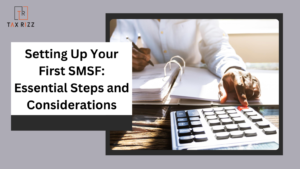Setting Up Your First SMSF: Essential Steps and Considerations

Setting up a Self-Managed Super Fund (SMSF) can provide you with greater control over your retirement savings and investment choices. However, managing an SMSF is no small task, and it’s essential to understand the regulations, responsibilities, and steps involved. This guide will take you through the critical stages of setting up an SMSF in Australia, highlighting important tax and compliance issues, especially for those in Melbourne and other parts of Australia.
What is an SMSF?
An SMSF is a private superannuation fund that you manage yourself, unlike industry or retail super funds. The primary purpose of an SMSF is to provide retirement benefits for its members. All members of the SMSF must also be trustees, ensuring direct involvement in managing the fund’s assets and investments. One of the key benefits is the control it gives over how the funds are invested, including options such as property, shares, and even collectibles.
However, managing an SMSF requires a solid understanding of financial, legal, and tax obligations. Consulting an SMSF accountant in Melbourne and a tax advisor in Melbourne is critical to staying compliant with Australian Tax Office (ATO) regulations.
Essential Steps to Set Up Your SMSF
Choose Your Structure
The first step in establishing an SMSF is deciding on the structure of the fund. SMSFs can have either individual trustees or a corporate trustee. While both have their advantages, a corporate trustee is often recommended as it offers better asset protection and flexibility when changing members.
Individual Trustees: Each member of the fund must be a trustee, and there can be no more than four members. All trustees are equally responsible for managing the fund.
Corporate Trustee: A company is set up as the trustee, and each member is a director. This structure is particularly beneficial for SMSFs where members might change, such as in family-run funds.
It’s advisable to seek the expertise of business accountants in Melbourne to help you decide which trustee structure suits your specific needs.
Register Your SMSF and Obtain a Trust Deed
Once you’ve chosen your structure, you need to register your SMSF with the ATO and obtain a trust deed. The trust deed is a legal document that sets out the rules for managing your SMSF, including the appointment of trustees, how benefits will be paid, and the types of investments allowed.
You will also need to register for an Australian Business Number (ABN) and a Tax File Number (TFN) for your SMSF and open a dedicated bank account for the fund.
Establish an Investment Strategy
The next step is to create an investment strategy that complies with the sole purpose test set by the ATO. This test ensures that your SMSF is maintained solely for providing retirement benefits. Your investment strategy should consider the personal circumstances of all members, including their age, risk tolerance, and retirement goals.
Typical SMSF investment options include:
- Australian and international shares
- Direct property investment
- Fixed interest investments
- Cash and term deposits
Managed funds
Having a clear strategy can help safeguard your SMSF’s assets. You should review this strategy regularly, especially as personal circumstances change. If you’re uncertain about which assets to invest in, a tax advisor in Melbourne can assist in making tax-effective decisions.
Tax Considerations for SMSFs
Tax Rates for SMSFs
One of the advantages of having an SMSF is the concessional tax rate of 15% on income earned within the fund. However, this tax rate is contingent on adhering to the compliance rules set by the ATO. Investment income, such as dividends and rental income, is generally taxed at this concessional rate.
When your SMSF starts paying retirement benefits (i.e., when members enter the pension phase), the income generated by the fund becomes tax-free. Consulting with a tax advisor in Melbourne is recommended to ensure that your SMSF takes full advantage of available tax concessions and avoids penalties for non-compliance.
Capital Gains Tax (CGT) for SMSFs
Capital gains tax applies to the sale of assets held within your SMSF. However, if the asset has been held for more than 12 months, SMSFs are eligible for a one-third CGT discount, reducing the effective tax rate to 10%. Again, when the SMSF transitions to the pension phase, capital gains may be exempt from CGT altogether.
This is a key area where an SMSF accountant in Melbourne can provide expert guidance, especially when it comes to planning asset sales and minimising tax liabilities.
Understanding Contributions and Withdrawal Rules
Contribution Limits
The ATO has strict contribution limits that apply to SMSFs, and exceeding these can result in hefty tax penalties. As of 2024, the contribution limits are:
Concessional (pre-tax) contributions: These are capped at $27,500 per year. This includes contributions from your employer as well as salary sacrifice contributions.
Non-concessional (after-tax) contributions: These are capped at $110,000 per year, or up to $330,000 over three years if you’re under the age of 67 and take advantage of the bring-forward rule.
Business owners, including primary producers, often have fluctuating incomes, making it vital to manage contributions effectively. A tax advisor in Melbourne can provide insights into how best to structure your contributions to optimise tax benefits while adhering to contribution limits.
Accessing Your SMSF Funds
Withdrawals from your SMSF can only be made when certain conditions are met, such as reaching the preservation age or retiring. The preservation age in Australia is between 55 and 60, depending on your birthdate. Withdrawals made outside of these conditions may incur significant tax penalties.
Before accessing your SMSF funds, ensure you understand the implications of withdrawing super early, and consult with business accountants in Melbourne if necessary.
Ongoing Responsibilities and Compliance
Managing Tax for Primary Producers and Family Businesses
For primary producers or those running family businesses, there are additional tax considerations when managing an SMSF. Income from business operations or agricultural activities may need special treatment to ensure it is tax-effective when contributed to the fund.
A specialist in tax for primary producers can help navigate these complexities, ensuring that contributions, tax deductions, and business income are properly structured to meet SMSF and ATO guidelines.
Annual Audit and Reporting
SMSFs are required to submit an annual tax return and undergo an independent audit each year. Failure to meet these obligations can result in penalties from the ATO, including the loss of your SMSF’s concessional tax rate. Keeping accurate records of all transactions, maintaining compliance with the investment strategy, and staying informed about legislative changes are essential for staying on the right side of the law.
Partnering with SMSF accountants in Melbourne will ensure that your fund’s tax return is lodged correctly and that the audit is conducted by ATO guidelines.
Company and Trust Registration for SMSFs
In cases where a corporate trustee is used, you’ll need to register a company with the Australian Securities and Investments Commission (ASIC). This company will act as the trustee for your SMSF, and you’ll need to ensure that the registration is in compliance with both superannuation and corporate law.
Working with business accountants in Melbourne who have experience in company and trust registration will simplify this process, ensuring that all legal requirements are met.
Conclusion
Setting up an SMSF can offer significant financial and tax advantages, but it’s crucial to get the setup right from the start. By consulting with experts such as an SMSF accountant in Melbourne, a tax advisor in Melbourne, and specialists in company and trust registration, you can ensure that your SMSF is compliant, tax-efficient, and tailored to your retirement needs. Whether you’re a primary producer or a business owner, the right advice will ensure that your SMSF is a valuable asset in securing your financial future.



